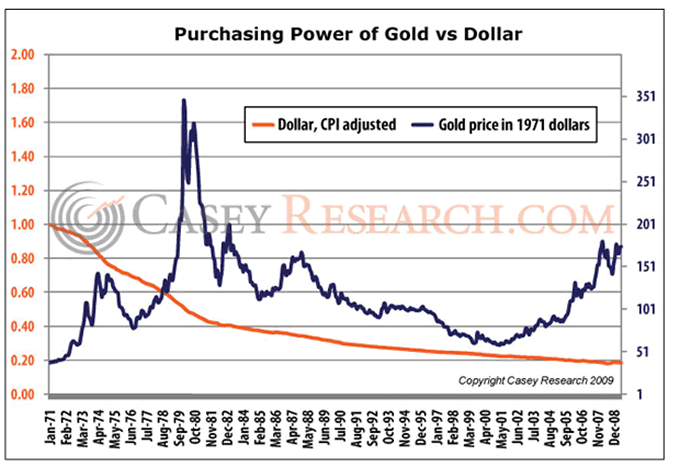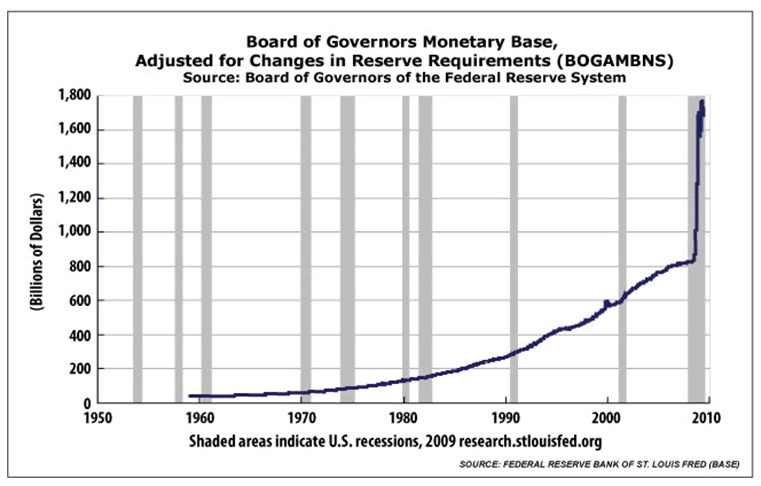U.S. Dollar Real Value Crash to 18cents
Currencies / US Dollar Oct 15, 2009 - 01:58 PM GMTBy: Jeff_Clark
 By Jeff Clark, Senior Editor, Casey’s Gold & Resource Report -“A dollar is worth only 70¢ now,” my Dad jabbered as we worked in the backyard. “And they say it’ll only be worth 50¢ in a few years.”
By Jeff Clark, Senior Editor, Casey’s Gold & Resource Report -“A dollar is worth only 70¢ now,” my Dad jabbered as we worked in the backyard. “And they say it’ll only be worth 50¢ in a few years.”
It was the mid-‘70s. I was helping my Dad build a dirt road to our barn and he wasn’t happy. Not about the hard work or humidity, but from what was happening to the dollar. Inflation was starting to kick into high gear, grabbing headlines that even a girl-chasing teenager could understand.
I remember being appalled by the thought of going to the store and having the clerk demand $1.30 for an item marked $1. Knowing what I know now, my thinking wasn’t that far off.
We lived in a small Pennsylvania town just a Sunday drive from where redneck jokes started. The local paper once ran a story of a blue-collar worker in the next county over who had stuffed a tidy wad of dollars into the back of his gun cabinet early in his working life. The money was discovered by the family after his death. While saving money is good, the duck-hunter equivalent of Family Mattress Bank & Trust won’t keep your money from depreciating; the stash of $10s and $20s had lost over half their purchasing power since he’d hidden them some 30 years earlier.
About the same time the gun locker was being lined with legal tender, both of my grandfathers – unbeknownst to me at the time – bought some gold and silver coins for me and likewise stored them away. I inherited one set a few years ago and got the others just last month. And the purchasing power of the coins is still the same as it was 30 years ago.
You can probably recall similar experiences about the dollar and what it was “worth” from your childhood. Even if you can’t, you intuitively know my conclusion is correct: the dollar ain’t worth what it used to be. And gold really does protect the purchasing power of saved wealth.
Happy Anniversary, Fiat Dollar
In August, the U.S. dollar celebrated its 38th anniversary as a fiat currency.
When Roosevelt issued his infamous 1933 presidential diktat, forcing delivery (confiscation) of gold owned by private citizens to the government in exchange for compensation, gold was $20.67/oz. In January 1934, the price was raised to $35/oz and the U.S. government pocketed the difference – and essentially devalued the dollar by 69%.
Yet the dollar remained convertible, and foreign central banks could redeem their dollar reserves for gold. This presented no problem when the U.S. was running trade surpluses and foreigners didn't have many dollars to exchange for gold. But in 1965, France’s President Charles de Gaulle started aggressively exchanging his country’s dollars for gold and loudly encouraged other countries to do likewise. That year U.S. gold holdings fell to a 26-year low.
Several schemes were tried to stop the drain on the U.S.’s hoard, including lifting the price to $42/oz early in 1971, but nothing worked. The run on the dollar did not abate. With the U.S. unable to eliminate its trade deficit, Nixon was faced with the stark reality of another dollar devaluation. He opted instead to close the gold window on August 15, 1971, ending dollar-for-gold convertibility. The dollar was suddenly off the gold standard, and half of U.S. gold holdings had disappeared. The greenback began to “float,” meaning it wasn’t tied to any standard and could be printed at will.
So how’s it done since then?
Fiat = Faulty
The following chart tracks what has happened to the purchasing power of the dollar and gold since the gold standard ended in 1971. After adjusting for inflation, you can plainly see the erosion of a dollar bill, now able to purchase only 18¢ of what it did in 1971, vs. an ounce of gold, which has not only stood up but increased in purchasing power.

Today, the amount of bubble gum you get for $1 could have been purchased for 18¢ in 1971.
In sharp contrast, you can buy about 3½ times more bubble gum today with the same gold coin you had in 1971.
There are two overriding conclusions from this chart:
- The dollar has consistently lost value since coming off the gold standard.
- While gold’s price has fluctuated, its purchasing power has endured. This fact will not change and is the reason you should own physical gold. It’s what I call the 4 P’s: your Personal Purchasing Power Protection.
The Dollar Is Going Lower
At Casey’s Gold & Resource Report, we firmly believe the dollar must go lower. But if you’re new to the topic, or unclear of our reasons, I’ll bet I can convince you in the next 60 seconds...
1. Money printing
The U.S. monetary base (coins, paper money, and central bank reserves) at the end of August 2008 was about $800 billion (minus dollars held abroad). In response to the economic crisis, the U.S. government has printed so much money that the monetary base has swelled to $1.7 trillion. This is the largest expansion in history and a staggering devaluation of the dollar. It means that for every dollar in America one year ago, the U.S. government has created 2.1 more of them.
Here’s the most recent picture of the monetary base:

You can see the unprecedented money printing that began last fall. The ramifications of this continual carpet-bombing of liquidity are clear: when banks begin to lend again, or because of reason #2 below, the dollar bill in your wallet will lose significantly more value.
You can believe in deflation as much as you want today, as long as you believe in inflation as much as you can tomorrow.
2. Debt
Taking on debt is like getting a tattoo: it doesn't go away, and it’s pretty painful to get rid of.
In the U.S., our current debt picture looks like this:
- National debt $11.6 trillion (but ’09 GDP is only $8.3 trillion)
- Government spending YTD $2.4 trillion (but tax revenue is only $1.2 trillion)
- Government bailouts $11.8 trillion (equals $38,815 per U.S. citizen)
But the granddaddy of them all are the unfunded liabilities (meaning, they are not covered by an asset of equal or greater value).
- Medicare/Medicaid liability $39.6 trillion
- Social Security liability $10.6 trillion
- Prescription drug liability $8.5 trillion
- Total unfunded liabilities $58.7 trillion
So where is the money to pay for all this going to come from? The government has only three choices to meet these liabilities:
- Raise taxes
- Cut spending
- Allow inflation to rise from money printing, diluting the debt burden
You can debate the likelihood of the first two, but everyone at Casey Research is personally betting #3 will come to pass.
Meanwhile, what is the liability of gold? ZERO. When you hold a gold coin in your hand, no one else’s problems, deficiencies, liabilities, or ability to pay come into play.
Although there are many uncertainties in the world, the future purchasing power of gold is not one of them. Buy gold until the monetary chart and debt figures above honestly don’t worry you. Let gold serve its purpose for you by protecting the purchasing power of the dollars in your possession.
Gold can indeed give you solid returns, especially in times of crisis like these, when people start flocking to it as an uncertainty hedge. But select gold (and silver) stocks can gain even more with gold’s run-up – so far we’ve seen up to 6:1 leverage from large-cap gold producers. One company in particular has provided steady gains even as the Dow and S&P tanked last year; that’s why we call it “48 Karat Gold.” Click here to learn more.
© 2009 Copyright Casey Research - All Rights Reserved
Disclaimer: The above is a matter of opinion provided for general information purposes only and is not intended as investment advice. Information and analysis above are derived from sources and utilising methods believed to be reliable, but we cannot accept responsibility for any losses you may incur as a result of this analysis. Individuals should consult with their personal financial advisors.
© 2005-2022 http://www.MarketOracle.co.uk - The Market Oracle is a FREE Daily Financial Markets Analysis & Forecasting online publication.



